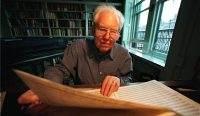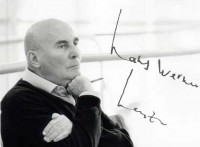A Double Eulogy: Celebrating Hans Werner Henze and Elliott Carter
Two giants of twentieth century music left us within a week of each other a few weeks ago. Hans Werner Henze died in Dresden, on October 26; Carter followed him within a ten-day, as he passed away at his NY home on November 5th, at the youthful age of 103.
There have been excellent obits written on both composers—I recommend the Guardian’s synthetic overview of Henze’s career, and New Music Box’s more personal remembrance of Carter by colleague and friend Joel Chadabe. For this blog I would rather spend a few words highlighting the tremendous amount of music that Carter and Henze gave to the guitar. Their contributions are different in scope and language. Carter’s include pieces from the two stylistic poles of his career: the neoclassical early years, and the ultramodernism of his maturity. Henze’s affair with the guitar was more sustained, as the composer kept incorporating the instrument in numerous chamber and stage works since its initial Holderin settings from Kammermusik 1958. As a matter of fact, Henze should be celebrated as one of a handful of composers (others include Peter Maxwell Davies and Toru Takemitsu) who have kept writing for guitar throughout their careers, despite not being guitarists themselves.*

Despite being fewer in number, the significance of Carter’s contributions should not be underplayed. The rarely-performed “Tell Me Where is Fancy Bred” evokes the sonorities of Elizabethan England as a fitting neoclassical complement to Shakespeare’s text. The contrast with Changes (1983), Carter’s most widely-known solo, is stark and immediate, yet the composer’s humor, energy, and musical vitality transpires equally from both pieces. My favorite example of Carter’s mercurial writing is found in Luimen (1997), a mixed ensemble piece that explores a variety of plucked and percussive textures (provided by the combination of vibraphone, harp, guitar, and mandolin) alongside trumpet and trombone; the piece was composed to incorporate a shorter guitar solo, Shard, written for David Starobin’s project New Dance. An earlier, rarely performed chamber work including guitar is Syringa, (1978), written for American new music hero Jan De Gaetani. Here’s a Youtube of this evocative and dramatic work.

Mentions of Henze’s guitar music usually evoke his popular solos: the three, beautiful miniatures Drei Tentos, and the monumental Royal Winter Music diptych. Yet again, there are more treasures to be found in the composer’s chamber catalogue. The Tentos themselves are excerpted from a larger work for string quartet, harp, guitar, and tenor, the above-mentioned Kammermusik. The unusual instrumentation (exacerbated by the fact that the forces are not employed together throughout the work) make performances of Kammermusik very rare, despite the indisputable beauty of the writing. Another rare work of Henze’s is the hour-long chamber drama El Cimarron, which tells the incredible tale of Cuba’s runaway slave Esteban Montejo, and includes some of the greatest theatrical writing for instruments of the century (how often do you see a flutist, a guitarist, and a percussionist chasing the singer around the stage?)
Finally, Henze should also be remembered as a writer. His autobiography Bohemian Fifths goes in great detail about how his personal life (especially his political leanings and sexual orientation) affected his career, leading to his decision to leave Germany for Italy in 1953. Another book of Henze’s, Music and Politics, articulates the need for an artist’s involvement with and reaction to the events of his/her times. I highly recommend both books to any performer, scholar, or enthusiast who is approaching Henze’s world.
In conclusion, there is a plethora of beautiful, energetic, and lyrical guitar works in the catalogues of Elliott Carter and Hans Werner Henze. I cannot think of a better homage to these wonderful (and generous!) composers than to consider programming some of their music in recitals and concerts…and don’t stop at the solos, as there are some real wonders to be found in their chamber repertoires.
